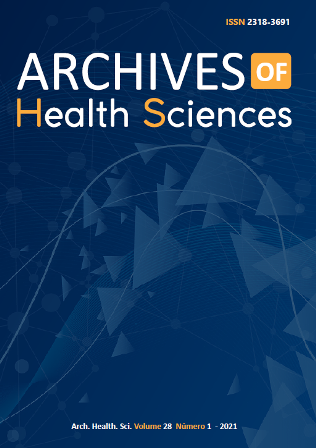Massive transfusion in traumatized patient with pulmonary contusion: case report
DOI:
https://doi.org/10.17696/2318-3691.28.1.2021.1786Keywords:
Shock; Acute Lung Injury; Blood TransfusionAbstract
Introduction: We can often associate pulmonary contusion with polytrauma patients and a significant cause of acute lung injury. More severe cases can trigger Acute Respiratory Distress Syndrome (ARDS), related to expressive morbidity and mortality. Besides, it is necessary to activate the massive transfusion protocol. We can associate transfusion with the emergence of acute lung injury, either by inflammatory immune mechanisms, such as transfusion-associated acute lung injury, and mechanisms linked to the innate response, either by excessive volume replacement or sepsis. Patients who have pulmonary contusion and require massive transfusion have an essential combination of elements that can induce inflammatory lung injury, representing higher morbidity and mortality. Objective: To alert the need to activate Massive Transfusion Protocol in patients with pulmonary contusion and list its likely consequences and care taken in these cases. Case Report: Description of a patient's issue with pulmonary contusion and Acute Respiratory Distress Syndrome, seen in an emergency service at the Base Hospital of São José do Rio Preto. Conclusion: Considering the benefits and harms regarding blood transfusion and massive transfusion, there is a tendency for its routine use in emergency services supported by well-established protocols. However, further studies are necessary to reduce transfusion-related complications.
References
Nathens AB. Massive transfusion as a risk factor for acute lung injury: association or causation?. Crit Care Med. 2006;34(5Supl):S144-50.doi: 10.1097/01.CCM.0000214309.95032.65
Sadis C, Dubois MJ, Melot C, Lambermont M, Vincent JL. Are multiple blood transfusions really a cause of acute respiratory distress syndrome?. Eur J Anaesthesiol. 2007;24(4):355-61.doi: 10.1017/S0265021506001608
Tranbaugh RF, Elings VB, Christensen J, Lewis FR. Determinants of pulmonary interstitial fluid accumulation after trauma. J Trauma. 1982;22(10):820-6.DOI: 10.1097/00005373-198210000-00003
Rendeki S, Molnár TF. Pulmonary contusion. J Thorac Dis. 2019;11(Supl2):S141-51.doi: 10.21037/jtd.2018.11.53
Požgain Z, Kristek D, Lovrić I, Kondža G, Jelavić M, Kocur J, et al. Pulmonary contusions after blunt chest trauma: clinical significance and evaluation of patient management. Eur J Trauma Emerg Surg. 2018;44(5):773-7.doi: 10.1007/s00068-017-0876-5
Mahmood I, El-Menyar A, Younis B, Ahmed K, Nabir S, Ahmed MN, et al. Clinical significance and prognostic implications of quantifying pulmonary contusion volume in patients with blunt chest trauma. Med ScMonit. 2017;23:3641-8.doi: 10.12659/msm.902197
Souza RC, Silva JHG. Manobras de recrutamento alveolar na síndrome da angústia respiratória aguda: uma revisão sistemática. Rev Inspirar Mov Saúde. 2015;7(4):34-9.
Urzêda LM, Amaral A, Silva E. Ventilação protetora e a posição prona na Síndrome do Desconforto Respiratório Agudo: relato de caso. RESC RevEletr Saúde Ciênc. 2015;5(2):34-47.
K Smith N, Kim S, Hill B, Goldberg A, DeMaria S, Zerillo J. Transfusion-related acute lung injury (TRALI) and transfusion-associated circulatory overload (TACO) in liver transplantation: a case report and focused review. SeminCardiothoracVascAnesth. 2018;22(2):180-90.doi: 10.1177/1089253217736298
Meyer DE, Reynolds JW, Hobbs R, Bai Y, Hartwell B, Pommerening MJ, et al. The incidence of transfusion-related acute lung injury at a large, urban tertiary medical center: a decade’s experience. AnesthAnalg. 2018;127(2):444-9.doi: 10.1213/ANE.0000000000003392
Guerado E, Medina A, Mata MI, Galvan JM, Bertrand ML. Protocols for massive blood transfusion: when and why, and potential complications. Eur J Trauma Emerg Surg. 2016;42(3):283-95.doi: 10.1007/s00068-015-0612-y
Downloads
Published
Issue
Section
License

This work is licensed under a Creative Commons Attribution-NonCommercial-NoDerivatives 4.0 International License.










